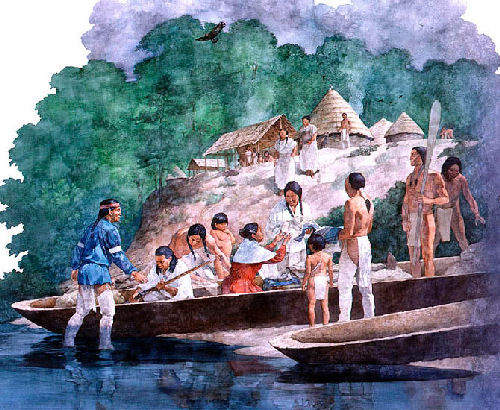

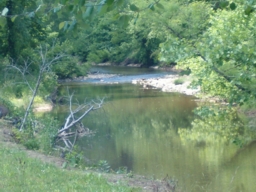 |
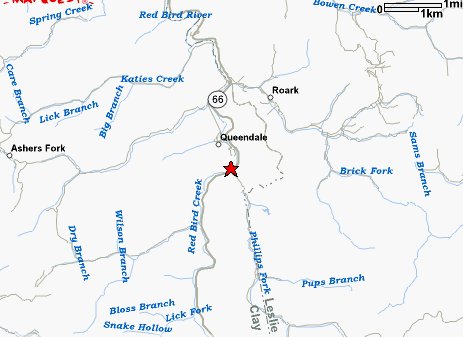 |
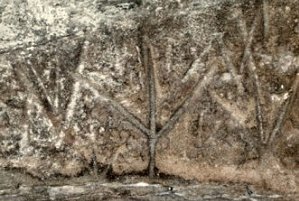 |
|
The rock exhibits symbols for all Cherokee clans. Photos courtesy of Tim Brock, May 2005 |
The Long Hunters had long hunted and traded with the Cherokee. In many cases they had fathered Cherokee children and been in semi-married relationships with Cherokee women. In these cases, by Cherokee custom, a man who supports his wife and children honorably is inducted into the woman's clan.European-American hunters on Cherokee land not attached to the clans in this way were in a perilous occupation. That the New River men, many of whom had been Long Hunters and Indian traders, would hold back in the attack on the Cherokee in 1776-1777 is to be expected, considering the way in which the war was conducted and their past ties to the Cherokee. As an example, Capt. Enoch Osborne's brother Ephraim married Mary Brock who is the daughter of Aaron Brock, sometimes called by his Cherokee name Cutsawah or Red Bird (after which a tributary of the Kentucky River is named), and one of the Blevins married a granddaughter of Doublehead, a Cherokee head man.Long Hunters not allied with the Cherokee would have been regarded by the Cherokee as thieves and would have lost their harvest of furs if caught (one such dispossessed "thief" was the famous Benjamin Cleveland, scourge of the New River Tories). The Revolutionary War was an economic disaster for the long hunts as many of the furs and skins destined for England now had no market. |
New River Notes, for the Upper New River Valley of North Carolina and Virginia: A Brief note about the Cherokee war of 1776-1777. http://www.newrivernotes.com/va/swift/cherokeewar.html |
|
Information from the Red Bird, a Cherokee, who came to Nine-miles, on the 4th September, to the house of Major Craig and told him that six or seven Indians were out, in order to do mischief on the frontiers, and, he believed, in the south of Holston; that part of the men were Shawanese, and part were Cherokees, from Running water or Nickajack. A few days afterwards, to wit: a day or two after Cockran was shot at, he came back and told Major Craig, that the Indians had heard that he had given the information, and were much dissatisfied with him, and that he was threatened with the law, referring to one that had been made some time before: “That any Indian, a native of the Cherokees, who should give intelligence to the whites of any orders which the nation took in council, or otherwise, he should forfeit his property, and be banished the country.” He then told him that John Watts had been to Pensacola; that he brought home seven horse loads of ammunition, and as many accoutrements as were sufficient to equip two hundred horsemen, to with, swords, &c. and that Watts was appointed to command the Creeks and the Cherokees who should be called into the field, and be for war, and that the Creek nation had met in council, and agreed to the appointment. That the determination of the War Department was, provided the Upper towns of the Cherokees would not come into measure of the war, that they would send out a party, and fall on the frontiers next the Upper towns, and so harass them, that the whites would be irritated to kill some of the Indians of those towns, which would induce them to consider the war general. He yesterday told Major Craig, that he might rely thirty Creeks had crossed the Tennessee, near Nive, about eight miles above the junction with the Holston, and supposed them out for the purpose he before me told him, and that the whites ought to be on their guard. That the party from the five towns, who were gathered together to declare war against the United States, and to commit depredations on the frontiers, were not so much stopped by the Glass, the Bloody Fellow, and Watts, as by Unanecata, who returned from Knoxville just as they had assembled. That the head-men of the other towns went talks to the five Lower towns, not to go so soon to war; their corn was not yet ripe; that the white people would come and destroy it and their towns, and they would not be able to stand hunger and cold both at the same time. The Red Bird adds, he does not know whether it was policy of the head-men to stop the party from going to war, or whether they meant that they were willing for war after the corn was hard and gathered, but he should soon know and inform Major Craig. Note. This information was delivered to Governor Blount by Major Craig, on the 13th September, 1792. The Red Bird is a fellow of understanding, and has heretofore been considered a great enemy to the white people, and is as likely to be in the councils of those who machinate mischief, as any other man. |
|
|
He was referenced in Louis-Philippe’s Diary of My Travels in America in the following excerpt, around 1799 after the death of Chief Red Bird:"We must be fair: the whites’ systematic spoilation of the Indians has not even slowed. All the Indians’ neighbors are greedy for their Tennessee territories. The last treaty has aroused serious discontent among the whites, who would like a war with the Indians so a new treaty can strip them of the coveted lands. Four months ago the whites assassinated two Indians (one a chief called Red Bird), hoping the provocation would lead to reprisals and trigger a war. The Indians demanded the surrender of the murderers. This was refused on the pretext that they should not be yielded over to Indian torture, and that according to the treaty they must be judged by American law. The whites promised to conduct an investigation and have the murders punished, but it would seem that nothing of the sort was done. I heard one of the assassins identified, so it would not be hard to find them. In the meantime, as nothing was done, the Cherokees assassinated four whites, and as nothing was said, all has been calm since." |
The young Chiefs try to dispel
rumors of the old Chiefs selling land and say they should be
praised for bringing peace to the Nation. They also chose a new
"Beloved Man" to replace the one who died.
|
|
"Aaron was preparing for trapping season, and made a trip to Madison Co., KY, for supplies. It is verified Aaron was in Madison Co. visiting his daughter Catherine in late August 1811 from the McLemore family archives. He departed Madison Co. sometime around the first of September for Pulaski Co., KY, where he lived in a small one-room cabin located on property belonging to George White. George had a huge family, some people say possibly seventeen children. Many of them already had married and some lived nearby, and in 1810 George still had six children living with him in the household. "George White had a son named Lambert who was born about the same time the family moved to Kentucky from Louisa Co., VA, ca 1785. Lambert often lived with Aaron, and helped him take care of furs. In the summer, Aaron would help George with farm work for allowing him to live on his land. "Lambert was with Aaron when he visited Madison Co. On the way home two brothers, Isaac and Jacob Gregory attacked, and left them for dead after scalping Aaron. The thieves stole everything Aaron possessed. "Somehow Aaron and Lambert made it back to Madison Co. where some passersby loaded them in a wagon and took them to the home of Jacob White, a family relative of George White, and a certified Medical Doctor. That was on September 3, 1811, and on September 11, 1811 Aaron died. He was buried in the White family cemetery the same day. The Cemetery is located at Foxtown, Madison Co., KY. "That evening eight men left Madison Co. with one idea in mind, to hunt down and hang Jacob and Isaac Gregory. Before departure, a letter was written to the Attorney General of Kentucky James Blair, and Governor Charles Scott, informing them of the action being taken, and it was signed by eight men. On September 16, 1811, they wrote another letter to Governor Scott and Attorney General James Blair, which informed them of the precise location where Isaac and Jacob Gregory were hung in a tree. The purpose of the letter was to allow relatives to retrieve the bodies and bury them if their families so wanted. Again eight men signed the letter. "The men retrieved Aaron's property, and delivered it to his daughter Catherine. Lambert White survived the ordeal and walked with a slight limp for the remainder of his life. He died sometime after 1840 in Pulaski Co., KY, when he was listed on that US Census of 1840 for Pulaski Co. as living alone and being between 50-60 years of age. His full name was Lambert Jacob White, and they called him Jake." |
by James Mooney (Paperback) |
|
|
Virginia colonists from England received land patents of 50 acres per man, plus 50 acres for persons they transported to Virginia. Bond servants received 50 acres when their 2-7 years of servitude were complete. All patents were preserved and are at the Library of Virginia in Richmond, and none exists for Reuben Brock. Abstracts were published by Nell M. Nugent in several volumes, Cavaliers & Pioneers: Abstracts of Virginia Land Patents, beginning with Vol. I, 1623-1666, Richmond, VA, 1963. Patent images are available on-line on the LVA website.All able-bodied males were required to serve militia duty. All extant county militia lists were published by Lloyd D. Bockstruck, Virginia's Colonial Soldiers, Baltimore, MD, 1988.See EARLIEST BROCKS IN VA. |
Abstracts of the Cumberland
County, Virginia, Court Order Books from June 1749 to May 1756, by Sheila Fretwell. George Brock was mentioned
on pp. 48, 61, 74, 80, 118, and 205 of the publication.
|
|
It is reasonable to think that Aaron Brock/Chief Red Bird's father (Great Eagle?) preserved an ancient male lineage identified in today's literature as the Cohen gene of Old Testament Jewish priests in the Cherokee hierarchy because:Bennett Greenspan and the scientists at Family Tree DNA have clarified it as belonging to haplotype J12f2.1+, an ancient form of the Cohen haplotype. The + allows for one-step mutations of the gene over time.Chief Red Bird's Y chromosome is not exactly matched by males living in Europe or descended from European or Old World emigrants, only by other Cherokee descendants.Chief Red Bird's father, from whom he received the haplotype, was a tribally identified Cherokee born about 1700 (since Red Bird himself was born about 1721 and killed in 1796). That time frame precedes the period of English/French/Spanish/Portuguese fathering of children by Cherokee women. Chief Red Bird's mother was unquestionably Cherokee. She was reportedly a member of the Paint Clan.The first European to marry a Cherokee woman was Cornelius Doughtery, an Indian trader born about 1668, who married Ahneewakee, a daughter of Chief Motoy II, about 1745.The marriage and naming patterns with Cornell, Sizemore and other Jewish Cherokee or Melungeon families are consistent.We can trace the line father-to-son in historical and genealogical records back to Motoy I, born about 1640, who married Quatsi (Patsy) of Tellico, a full-blood Cherokee of the Wolf Clan. In 1640, the Cherokee had little contact with Europeans. It is virtually impossible that Motoy's father could have been a European. If he had been a European, it is also virtually impossible that he or his male descendants could have achieved the standing of principal chief. His male descendants included Motoy II, Red Bird, Raven of Hiwassee, Tathtowe, Bad Water, Old Hop, Old Tassel, Doublehead, Tuckahoe and other Cherokee chiefs recorded in British and American Indian agency records.Other scenarios, such as adoption, are possible, as with any interpretation in genetic genealogy research, but none is more likely than the one I've just sketched.Although most male Cherokee lines were extinguished in warfare following European contact, the survival of the Red Bird or Motoy line in the Brock Y-chromosome is a notable exception. The male story mirrors the mitochondrial lineages in my article, "Anomalous Mitochondrial DNA Lineages in the Cherokee," and shows that Middle Eastern founder types ruled the Cherokee nation from its inception.That the Motoy line is demonstrably from the ancient Middle East (and likely Jewish) is consistent with Cherokee origin stories, as summarized in my book Old Souls in a New World: Greeks, Jews and Egyptians in Native America. The name Motoy (title, actually) means Mariner or Admiral and commemorates the Egyptian expedition of 212 b.c.e.
|
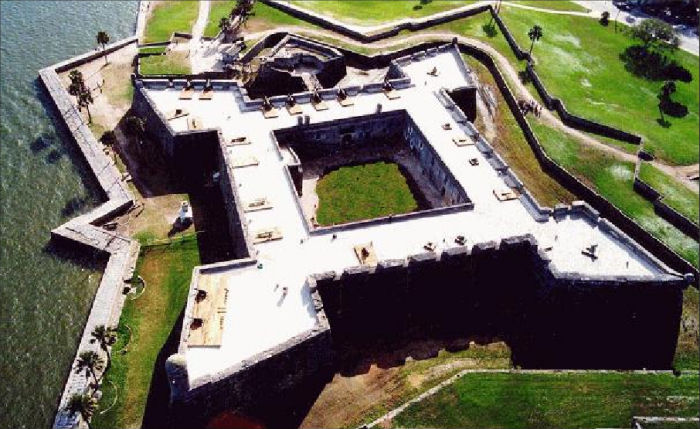 |
|
|
 |
One European who married a Cherokee was Christian Gottlieb Priber, who immigrated abt 1735 from Zittau, Germany, went quickly to live with the Cherokee which he saw as an idyllic lifestyle. Leaving a wife and children in Germany who he meant to send for, he instead married a daughter of the great Cherokee Chief Moytoy at Tellico (now in SC). Her name is unknown, but their daughter Creat Priber married Chief Doublehead, who may've been Aaron Brock/Red Bird's brother, in the area now Stearns, KY. According to the interview of Felix Begley by Mrs. Annie Walker Burns, Christian Gottlieb Priber and his Moytoy wife had four daughters, names of the other three are not known. It was fairly common in that time and place for siblings to marry siblings. |
|
"Brother. [No. 4 1797 Recorded] "This conduct my brother has a bad appearance and as I told you before will be attended with disagreable events Should your people be so foolish And unwise Not to decline Such practices."You mention that I wrote you in a threatning Manner, but my brother if you listen to the Words of my letter, there is no threats [added: in it.], I have only spoken to you the [added: language of] truth, and the fatal consequences, that Must attend your Nation, should you be so imprudent As to again go to War — I dont nor never did Speak to you with a false toungue, nor do I wish your people to be treated ill, but on the contrary that they may live in peace and safety and raise their children in Quietude."I know very well, that some of our [added: the white] people are bad men and have been guilty of a horrid Crime in killing the red bird [Red Bird] and Will, and I expect that when ever they can be taken they will [added: shall] suffer for it, one of them has run away and the other as yet is not taken; as I told you in my last I tell you in this, that the innocent ought not to suffer for the guilty, neither ought your people to take Any Satisfaction until you had first made your complaint And stated your sufferings. It is impossible for me to know when damage is done to your people without you inform me; and your own good sense will point out to you that A Murderor seldom ever discovers upon himself, which I Suppose is the reason why your people denies they have done any Mischeife."You say you have been a long Journey and While at philadelphia received very different talks from that of mine; and say that I say you are but a handful of people and in consequence of our superior[ity] in Numbers [added: Suppose] we have a right to do as we please — I deny saying we had a right [a right] to do as we please [added: &] on any such a supposition, neither is there any such a word in any letter it is true I said you were only a handful of people, which is the truth and I also advised you of the danger of going to war; If the people at philadelphia have told you that you were [added: are] a Numerous and strong people, and that you ought to go to War and kill your white brothers, they have not told you that which is true, nor that which would be for your good and the interest of your nation [added: was you to take such advice]. I spok what I said in my letter was to convince your nation of their danger and the Great evils that always attend a war, and the distressing condition your people would be in, Should Such a thing take place — You say that you Wish I would talk to My people and tell them not to cross the River Tennessee or to survey your land — I have often told them that, neither do I wish or intend any such thing should be done. But you know I am a great Way from that place, and cant See what every foolish Man is doing, I expected that the gaurds at Tellico, and your own would stop such people from Crossing Over, and I Suppose, [added: they] Would was they to see them, but neither them nor myself can see the transaction of every bad man, no More, then [than] you can your people, who come over on our side And kill our people and steal our horses."Now brother I hope I have Said enough to convince You, that I dont Wish our people and yours to go enter into War against each other, and I hearby declare that I wish to have peace and friendship subsisting between the two Nations, and shall with all my heart and strength do every thing in my power to promote the same — I hope You will do the same and [added: also] endeavor to keep your people Within the bounds of reason; and let us try to prevent Any further effusion of blood. I wish us to live friendly and bury all Anemosities deep in the earth, If you have complaints, the government will redress them, and you know they are taking measures to effect the same, but if your people will undertake contrary to the treaty Articles of the treaty to redress themselves, you cant expect the government will do it — I request that you will make enquiry into the murder lately done on Pigion; and if You can [added: possible] have them [added: the murderors] punished agreably to the Articles of Treaty. — your people could have no color of excuse for committing Any depredations on that Quarter for they are not on lands claimed by your Nation, Neither have they interupted any of your people —"I hope to have an answer
from you as soon as possible.
|
"The Indian Chief for whom Red Bird Creek in Clay County was named is known as member of the Whitetop Laurel Band of Cherokees from North Carolina. He was a great hunter and allured by the game in this remote region. He finally took up residence on the creek that bears his name at the mouth of Jacks Creek in this county. He came to his death by the abarice of the "pale face". There lived with him a crippled Indian named Willie. This man dressed the skins which Red Bird brought to their wigwam and looked after the culinary department of their house. Some hunters from North Carolina, greedy and unscrupulous, came to the wigwam and murdered Willie. Then they secreted themselves and awaited the return of the brave chief who had long before buried his tomahawk and for years had been living in peace with the white man, and as he approached his crude castle the bullet of an assasin laid him in the dust. They threw his body into a hole of water nearby which is still called "Willie Hole", and from which John Gilbert and others took him and buried him. One tradition is that he was sitting on the bank of a creek fishing when he was shot and that he fell into the creek." |
|
"The Strong family of Breathitt and Owsley Cos., KY was established by William, who was born about the year 1768 in VA and died about the year 1848. He was married about the year 1790 to Jennie Callahan (commonly called Jane), who was born about the year 1779 and died about the year 1815. She was a daughter of Edward and Mahalah Brock Callahan. Mahalah was a daughter of AARON BROCK and a sister of JESSE BROCK, who lived in Harlan County. The Brocks were part Indian. William Strong was a son of Daniel and a grandson of John Strong. They originally came from Ireland."Before coming to KY William was living at Holston Springs in Scott Co., VA."About the year 1800 or 1801, a party was organized in Scott Co., VA, to come to KY. This party was composed of Edward Callahan and family ~ William Strong and family ~ Daniel Davidson and three sons Samuel, John, and Robert, with their families ~ also Roger and Robin Cornett. Some reports say that the Cornetts came a year or two previous to this time. The above mentioned parties brought along with them their livestock ~ household goods ~ slaves and other possessions."William Strong, Samuel Davidson and the two Cornetts had married daughters of Edward Callahan. After arriving in KY the above named parties settled on the North fork of the Kentucky river at and near the mouth of Grapevine Creek in (now) Perry Co."William Strong acquired a tract of land on the opposite side of the river from the mouth of Grapevine. It extended from near what is now Chavies down the river so as to include Strong's Branch. On this land he erected a log building where he made his home for some eight or ten years. He, as a deputy assessor, made the first assessment of all land and personal property on the North fork, which was then embraced in the new County of Clay. He was leader of the 'North Forkers' in the famous 'cattle war' which began in the year 1806. . ." |
"ELIJAH BROCK TESTIMONY Given personally to ANNIE WALKER BURNS (deceased 1942): JESSE BROCK WAS THE FIRST SETTLER ON WALLINS CREEK, KENTUCKY. He was about three-quarter indian, and had so much indian blood in him, that he had no trouble in living among the indians who were thickly settled in the mountains when he first came, raised his family among them, hunted along with them, with no trouble whatever. He homesteaded where Park Howard lives at this time."See full text of Elijah Brock's interview.(NOTE by Mrs. Burns, "It is said that Park Howard knows where Jesse Brock's grave is, and has designated same to satisfaction of members of the D.A.R.") |
|
 CHIEF RED BIRD
~ Excerpt from his book-in-progress, Kentucky Cherokee:
People of the Cave
CHIEF RED BIRD
~ Excerpt from his book-in-progress, Kentucky Cherokee:
People of the Cave
|